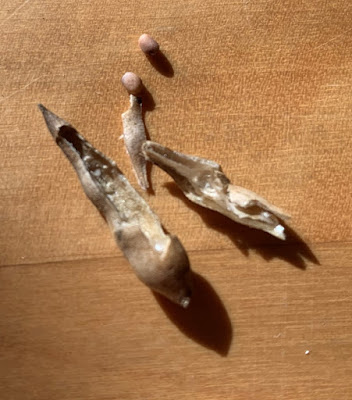Last week I reported that the watermelon vines had started to set flowers - well, this week on Monday we say baby melons forming (so cute!) and by today those "babies" are baseball-sized! These are 'Doll Babies' from seeds I got from Renee's Gardens and are a small "icebox" variety that stays relatively small. I cannot wait to taste them, but I also don't want to pick them before they are fully ripe -- patience!
Elsewhere in our plot, the soy bean and okra plants are continuing to put on rapid growth. I harvested the one fruit so far from the container eggplant 'Picasso'. I ate the couple of strawberries I had before the slugs or birds could. We harvested tomatoes twice this week to keep up with them The basil made need a big cut-back soon Maybe I'll do a big batch of pesto next week.
Finally, I checked the cucumber vines for female flowers to hand-pollinate, if needed, and I can across this set of two. Twins? I will keep a close watch on them and let you know.
Finally, I checked the cucumber vines for female flowers to hand-pollinate, if needed, and I can across this set of two. Twins? I will keep a close watch on them and let you know.
What are you growing and harvesting this week in your edible garden?
About Fenton Friday: Every Friday during the growing season, I'll be giving you an update on my community garden plot at the Fenton Street Community Garden just across the street from my house in zone 7 Mid-Atlantic MD/DC border. I'm plot #16. It is a 10 ft x 20 ft space and this is our 8th year in the garden. (It opened in May 2011.) See past posts about our edible garden by putting "Fenton" into the Search box above.



























